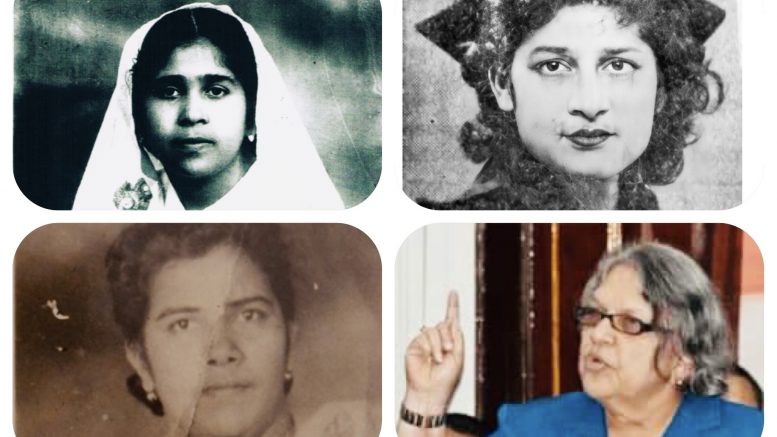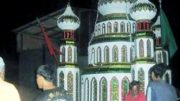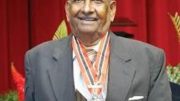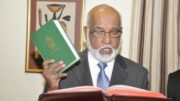30th Ramazan 1443, 1st May 2022:
I reflect on our women, the backbone of our families and builders of communities. Amongst our own families are our mothers, sisters, aunts, grandmothers and all women who have raised families. Many women have raised their own children, orphans, or those on the margin of society. It is my hope that this paper opens a wider conversation about women in Guyana. And to reflect on this Ramazan 2022, my paper focuses on the Muslim women of Guyana who have been the bedrock of their family. She is that woman who woke at dawn to start her day with the Fajr Namaz, preparing meals, sending her children off to school; taking up a hoe, a fork or machete to work the sugar and rice fields; taught her children Quran and Namaz, and has an active role in the Masjid activities.
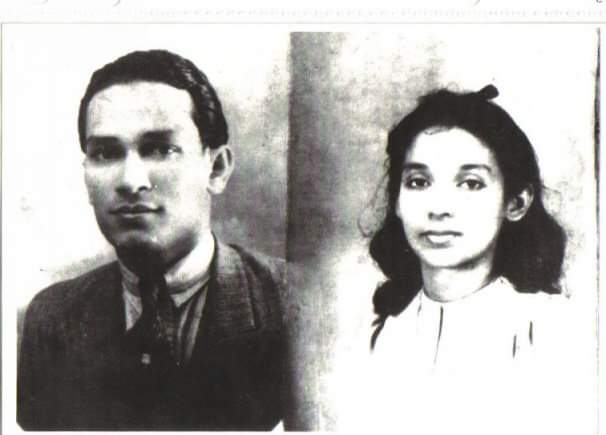
My Grandparents, Esau and Maryam Khan. Esau is the first cousin of Bibi Sahara Siddique of Vergenoegen, their ancestors all hail from Maryville, Leguan.
A devout Muslim, Khadami Khatoon, my great-great-great-grandmother (GGGM) of Mary and Eliza, and mother of Sankar and Dookie (Maula Baksh and Khuda Baksh), was one of the early founders of the Number 78 Corentyne Masjid (Guyana Chronicle, 1964). In addition, Goolonia Khatoon, another GGGM was kidnapped from Banares, locked up at Calcutta, and put on board the King Arthur in 1878 for Guyana. She arrived with her infant child, Sakinatul Sherif, at Mary and Eliza, Skeldon.
In addition to Sakinatul, Goolonia’s other children born in Guyana were Shahibzadee (Shehzade), Zainab, Nur Khan and Qabil Khan. Shehzadi was the wife of Abdool Rahaman of # 78. One of their children, Sultan Rahaman, served as head of CIOG for some time. Zainab was married to Ibraheem Nur-ul-Deen and Sakinatul to Sankar. Ghanim Khan was one of the children of Qabil Khan. These families did well and contributed to the development of their communities and Guyana at large. The success of these families and their businesses rested heavily on the shoulders of these devout Muslim mothers and entrepreneurs who were dominant in family businesses.
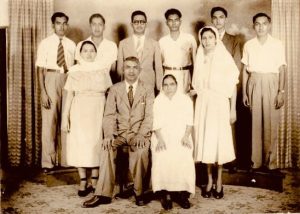
The Abdool Rahaman family. Seated in front are Mr Abdool Rahaman and Mrs Shehzade Rahaman, at the right of Shehzade Begum is Azeema Rahaman. Far-right in the back row is Mr Sultan Rahaman.
Names and Relatives Explained
Guyanese Muslim names come from the Urdu Language, the mother tongue of Muslim Guyana. Urdu is a daughter language of Farsi and the language borrows heavily from Arabic, Turkic, Farsi and North Indian Languages. The word Urdu is of Turkish origin. Common among Muslim girls in Guyana is the name “Bibi,” and it is a prefix that goes with another name like Bibi Ayesha or Bibi Haniffa. Bibi means lady like the Turkish term, Khatoon. So it’s common and especially during the older times that many women in Guyana carried the Suffix “Khatoon” (Lady of rank). Khatoon is the feminized version of Khan, a title of nobility that the Central Asian Turks bestowed on various people of West and South Asia. Hence, we have names like Hamida Khatoon or Famida Khatoon, etc in Guyana.
From Arabic, the term “Nisa,” and not “Nisha,” which means lady, became popularized because Mughal princesses carried beautiful names like Mehrunissa or Zaibunissa. Next, Begum from Turkish is the female version of Beg/Baig and it’s a title for the Lady of the House or a lady of Status. From Farsi we have the term “Bano or Banu,” Lady or lady of rank; for example, the name became popularized since Arjumjand Bano, wife of Mughal Emperor, Shahabuddin Muhammad Khurram carried it. And of course, the wife of Yusuf Khan (Dilip Kumar) was Saira Banu. Common among the Guyanese Muslims was the Feminization of names like Jamir/an, Ameer/an or Nasib/an. Eventually, the corrupted version of “Nisha and Moon” proliferated across Guyana and that was due to the loss of the Muslim’s mother tongue, Urdu.
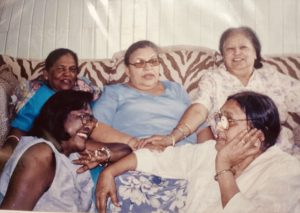
Always enjoying her extended family is Bibi Safora Shadick, centre with two of her Puphu, Zamilla and Sarah; at her left is her Chachee, Mrs Swabera Baksh and below her is a cousin. Swabera is the mother of Shakira Caine, former Ms Guyana and 3rd Miss World Contestant. Rozim Baksh, her husband died young and Swabera moved back to Hague where her Rahaman family hails from. Her brother, Haleem, was married to Bibi Shadick’s aunt, Sarah. “Swabera never remarried. She was an accomplished seamstress who made a good living,” says Ms Shadick.
According to Ms Bibi Safora Shadick (Gaphur), among the Muslims, no family members nor community elders were called by their names. Muslims referred to their paternal grandparents as Aja or Dada and Ajee. Father’s brother and sister were Chacha and Puphu with spouses Chachee and Pupha. Mother’s brother and sister were Mamma and Khala with spouses Mamee and Khaloo. Maternal grandparents are Nana and Nanee.
I reintroduced respectful Urdu terms from Farsi and Turkish languages that our ancestors used such as Khatoon (Lady/Lady of Rank), Begum (Mrs/Lady of Rank) and Janaab (Sir). I have reintroduced them as recognition of our culture.

Shakira and Michael Caine
Teacher Rai, Ms Bibi Safora Shadick Gaphur
Ms Bibi Safora Shadick (Gaphur), affectionately known as ‘Teacher Rai’, short for Raienah, is a daughter of Leguan and was a dedicated teacher for 34 years, many of which were dedicated to educating the children of Leguan, her place of birth. Her students have great praises for her as an ‘intelligent, hardworking and no-nonsense role model.’ She is the granddaughter of Abdul Gaphur of Leguan which connects her by blood to Shakira Caine (Baksh) whose father, Rozim Baksh was the son of Mir Baksh, brother of Ms Shadick’s grandfather. She is also related to the families who were killed during the Maryville Mass Murder of 1934. Ms Bibi Safora has a vast knowledge of the historiography of the region; its people and history, especially since she comes from a huge clan.
Bibi Safora is the middle child. Her siblings were Nazam Akbar (Shahib), Sheik Mohamed Nazim (Aleem), Bibi Raheel (Zarina), Bibi Safora (Middle Child) Mohaboob Allim ((Babil), Bibi Zeenatoun (Ferina), Nariman, and the twins Kabeel and Acklima.
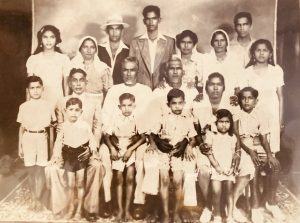
Back row: Jum agee who was Mir Baksh’s second wife. Shakira’s father was Rozim Baksh. Mir Baksh on the left is Abdul Gaphur’s brother. They are sitting next to each other.
Middle/front row: Rasheed, Ashraf (Taj ‘s son) on his father’s lap. Razack is held by MIr Baksh. Azeez is held by Abdul Gaphur. Hazra is held by Betty and Farouk stands next to Betty. Ameena (Soda) and Azeez lived next to Sharifan and Budya on adjoining lots in 3rd St Windsor Forest. Soda and Azeez children were: Zaiboon, Azimoon, Narima, Afzal, Shameer and Fazil most of whom live in Canada. Sharifan (Betty) and Budya’s children were Shirool, Meena, Karima, Shaffiah, Halima, Fazie and Hafeez.
Some live in England and others in Canada. Hazra, Razack and Azeez are Betty’s children from her first marriage to Amin from Wakenaam. He died, and then she married Nazarally (Taj) who had three children from a previous marriage. Taj and Shafiran (Betty) had many children. Soda (Ameena) and Sharifan were married to brothers Azeez and Budya. Their sister Jumrattan was married to Rustum all 3 marriages on the same day. Azeez, Budya and Jumrattan are from Windsor Forest.
Bibi Safora attended Maryville Canadian Mission School and later was awarded a scholarship to Bishops’ High in Georgetown. Upon finishing high school in 1961, Ms Shadick began teaching in Leguan at the said school she attended. Shadick attended the University of Guyana and obtained a Certificate in Education and a Bachelor’s degree in Education. In 1996, she earned a Bachelor of Law at the University of Guyana, and in 1998 a Certificate of Legal Education from the Hugh Wooding Law School in Trinidad. The same year, she was admitted to the local bar.
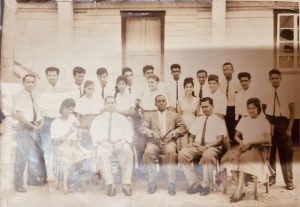
With the staff of Maryville Gov. School, Young Miss Bibi Safora Shadick at the centre of the middle row, and behind the HM who was retiring in 1963.
Ms Shadick was the first Muslim woman of Indian origin to hold the title, Pro-Chancellor of the University of Guyana. For a Muslim woman of Indian origin, it is unheard of to head the world of Academia. That was reserved for firstly Whites, then and still considered a place for educated Blacks to show more “schooling” than Indians in Guyana.
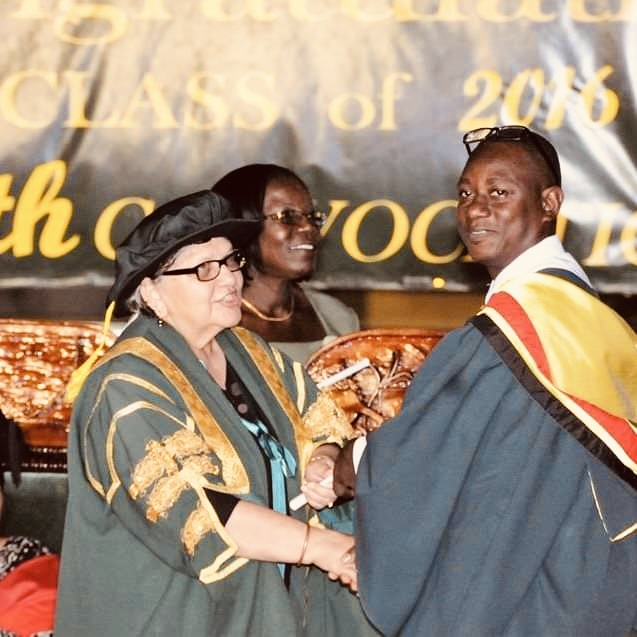
The University of Guyana, Pro-Chancellor during the graduation of 2016
Ms Shadick was a Member of Parliament for 14 years, and 5 years of that period served as a minister. She currently sits on the Guyana Election Commission (GECOM).
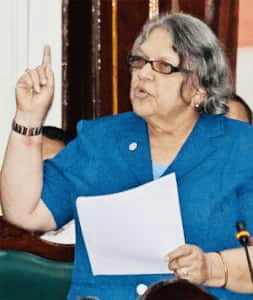
Ms Shadick speaking in Guyana’s Parliament
Bibi Safora is committed to every child getting an education and pensioners getting the respect and help that they deserve. “I know that, from my childhood, I always wanted to be a teacher and that’s why I taught for 34 years,” she said in an interview with the Guyana Chronicle (April 25, 2001).
“I think I decided that teaching was my calling. It was never my dream or anything like that, but I loved it and did it well. I have this thirst for learning new things and imparting what I learned to others. I also wanted to be a lawyer to help the less fortunate. I did that after retirement from teaching. Have been practising law for the past 23 years now.”
Ms Shadick’s history and culture are fascinating in that it is colourful, rich in tradition and one of struggle and perseverance. She is no pushover. Many Muslim Guyanese can relate to her story.
Her grandfather, Abdul Gaphur was born on Thursday 13 March 1890 in Leguan and died on Sunday 20 February 1966.
“His wife, my father’s mother, Nasiban, was born on the Essequibo Coast. After her death, Gaphur remarried a Hindu woman from Uitvlugt who had children of her own from a previous marriage. Her children with my grandfather were Farouk and Rasheed.”
Mir Baksh, Abdul Gaphur, and Nabi Baksh Umrao were brothers. There were other siblings also and including girls. One of Gaphur’s sisters, Munawan was married to Abdul Rahaman Khan, the owner of Maryville Estate.
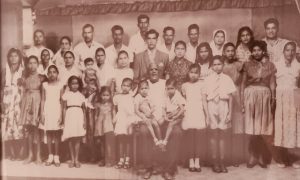
Mr Abdul Gaphur Mia seated with his Immediate and Extended Family
In her family were two women named Jumrattan. “Jum Chachee was married to Mir Baksh after his first wife, Kariman Cachee died.” His brother Nabibaksh Umrao was married to Jumrattan. After he died, Jum married Mir Baksh. The two ladies were sisters. These were common situations among Muslim families. Rustom, a son of Gaphur, was married to another Jumrattan, and they were the parents of Kalam and Feeza and Azim who moved to Canada.
“Noor Mohammed, I knew him as Duncan Mamoo, so I know he was my grandmother, Nasiban’s brother. He may have been born in Essequibo also.” Duncan Nana’s wife, Bibi Shahara Nani, who was born at Long Dam, Vergenoegen in 1904, father Saddik, came from Ghazipur, India in 1875 at age 9 to Maryville with his parents.
“Her (Rafi) and I are close. In fact, Rafikan, daughter of Duncan Mamoo and Bibi Shahara, kept my sister and brother at Zeeburg when they had to attend high school in Georgetown.”
In discussing the name confusion as to why she doesn’t carry the name, Gaphur legally, she said, “My father was the second son of Abdul Gafur. Although he was legally entitled to, he never used the surname, Gaphur. He was always known by his one name, Shadick. His brothers were Hamid, Rustum, Mustapha, Farouk and Rasheed, who is the only one still alive in the UK somewhere. The sisters were Sharifan, Shafiran (Betty), Sarah and Zamilla (Zam), twins who are still both alive and reside in Canada.” Shafiran was married first to Amin Hack of Wakenaam and had three children.
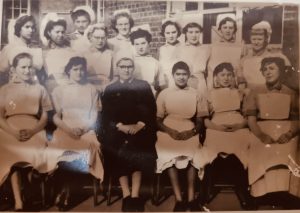
Bibi Safora’s cousin, Hazra Sheikh, nee Hack, far left at the back row, studied nursing in the United Kingdom around 1956
Discrimination, Names and Struggle
In Guyana, many children have a “home name, ” and in Ms Safora Shadick’s extended family home, “every child had a home name chosen by our paternal grandfather, Abdul Gaphur.” Mine was Raienah. That was not registered but is my more well-known name. Rai the short version.” Raienah, also spelt Rehana, is Persian in origin and means sweet fragrance.
“My former headmaster rounded it off from Rai to Roy, which was the name on the school register throughout my primary school life.”
I was never aware that my name was in fact Bibi Safora until the Government County Scholarship results were published in 1956. I was 10 then. At Bishops, the White people decided to include the name by which I was known, so I became Bibi Safora Roy Shadick, at least on the BHS record.”
I also found out that since my father’s name was marked “not stated” on my birth certificate, I was not legally entitled to use it. However, my O’level certificates had it, so before I could have been employed as a teacher, I had to have a Deed Poll, to legally use the name Bibi Safora Shadick. The school was a Christian denomination and I was asked to “adhere”. I refused. I was strong-headed and did not hesitate to show it.”
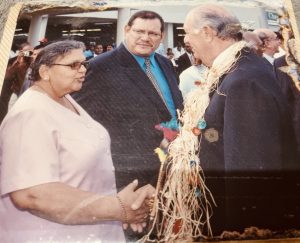
Receiving the President of Brazil to Guyana, Lula Da Silva when she was a minister in the government
“And “adhere” meant to accept or follow the status quo; not necessarily fully convert. At least that was my understanding. I was never asked to convert.”
Like Ms Shadick’s struggle, many immigrants from India and their descendants bore one name. Muslim names were often anglicized and bastardized beyond recognition, examples: Ramjohn (Ramazan), Siddique (Siddick), Jaan (John), Khatoon (Cartoon), Maqdoom (McDoom), etc are just a few examples. Muslim marriages were not recognized so children had no right to carry their father’s names; non-Christians were asked to convert to take up good jobs. For some of these reasons, Muslims were stubborn to neglect their culture, and many decided to go into business for themselves. Hence, a large portion of Muslims in Guyana got involved in the goldsmith businesses, rice, timber, dry goods trading, cinemas, car dealerships, grocery shops, animal husbandry, farming and the mining industries.
“The British were very condescending that way, showing their empathy with us natives in their “Whiteman Burden’s civilization mission, I suppose,” concludes Ms Shadick.
Teacher Rai’s Maternal Ancestry
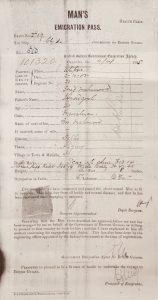
Syed Mahamood Emigration Pass
Bibi Safora’s mother, Mariam was born in De Kinderen Estate where her father Syed Mahamood was a driver. She recalls, “He was born in Afghanistan, but came via Delhi to Guyana in 1912 likely. Syed Mahamood was quite educated and was made a driver. My maternal grandmother was born in Aurora, on the Essequibo Coast, to a quite prominent butcher with the family named Baksh.”
Looking at Bibi Safora’s grandfather Syed Mahamood emigration pass, he arrived in Guyana in 1905 from Afghanistan via New Delhi. It would seem that he was an urban man who spent some time in the cosmopolitan city of New Delhi. The Syeds are said to be descendants of the Prophet Muhammad (SWS). Many Afghans sought opportunities in India and a handful ended up in Guyana where they were instrumental in planting firm Islam in Guyana. His father was Amadgool, and his brother also carried the name Mahamood and that’s not unusual. Most Afghans carried three to four names and likely his entire name was not recorded. Mahamood is a variant of Muhammad, and it is a revered name among Muslims. For example, the Afghan founder of the Queenstown Jama Masjid, Gool Mohamed Khan’s brother was also named Nur Mohamed Khan.
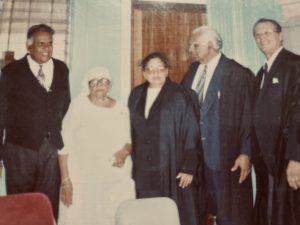
“My grandmother’s father (my great grandfather), was Nabi Baksh, and she was the only child of her mother, who was reportedly never comfortable with her in-laws, and became septic and died after my grandmother Subrattan was born. She refused to allow a doctor or her mother-in-law to attend to her. Nabi Baksh remarried and had several other children. There was still a masjid in the same family yard.”
Asked about the women in the Gaphur and Mahmood family, Bibi Shadick Gaphur said, “Definitely not public figures. All family women, some who were careful to educate their children.”
Bibi Safora Shadick is a woman of strong faith and resilience and has earned great respect from her community and Guyana at large. Questioned about her role model and impetus, she said, “I have always been a self-starter. In fact, even family members do not understand what motivates me. They appreciate what I do. I am not sure why I moved to do all that I have done.”
“Allah’s guidance is quite significant in my existence and actions. It’s Allah’s guidance, and in this, my faith is strong.”
Jesse Shareed, a native of Leguan said, “I love your historiography of our women. I particularly love the way you fit in Teacher Rai. She is indeed a treasure trove of knowledge on the history of Leguan. Safora Shadick is quite a gem. For those of us that grew up together, she is revered.”
Stories of Leguan from Safora Shadick
According to Bibi Safora Shadick, Jabbar was the rice factory manager. He owned property adjacent to the Maryville Masjid. I am unsure if he is related to A. R. Khan, but he had a grocery and convenience shop, which his wife, Zabida ran, she said.
“Rice farmers were encouraged to buy on credit from his shop and pay when they sold rice/ paddy to the rice mill.Many, including my parents, later discovered that they were being overcharged, tantamount to paying interest on their accounts,” she recalls.
“I remember my own mother confronting him when she found out that his records showed that my older sister had bought groceries on credit during a period when my mother was in Georgetown having an emergency operation and recovering at her sister’s home.”
My sister and younger siblings were staying with Rustum and Jum Chachee and never bought groceries or cooked.
“Zabida, his wife, had a stroke and was incapacitated when the shop and house burnt with her and Jabbar inside. Sad and tragic. They had, I think, two daughters. Unsure of where they are now.”
Bibi Hamidan Shakoor, Mama
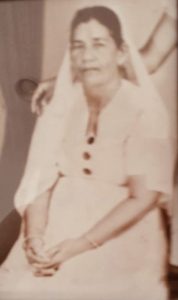
Bibi Hamidan Shakoor, Mama
In our own Maida Plantation, Upper Corentyne, was Bibi Hamidan, a seamstress fondly known as Mama. Many young women came to her home for seamstress training. Bibi Hamidan was born in 1905 and a native of Cumberland, Corentyne. She was an excellent role model and many young women in the community enjoyed being in her company. She was a charitable, kind and pious woman. Mama taught these ladies who frequent her home, Wudu, Namaz and Quran. She dedicated her house to Madrasa.
In 1947 she also contributed to the Pakistan Refugee Fund which was a collection to aid the refugees who suffered during the 1947 division of the Indian Subcontinent.
Bibi Hanifa Ishack Hossain
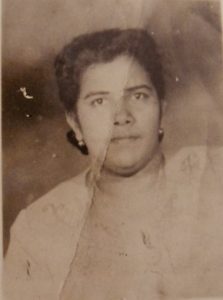
Bibi Hanifa Ishack Hossain
Bibi Hanifa Begum is a granddaughter of Leguan and # 78 Skeldon. She comes from the Sankar clan on her mother, Bautlan’s side and on her paternal side, Fher Khan who hails from Leguan and Vergenoegen. Bibi Hanifa managed a coconut estate with the support of her husband, Ahad Ishack Hossain from Suriname. Hanifa left Suriname to administer the Maida Coconut Estate in the Corentyne.
Bibi Hanifa kept ties with her father’s family “over the river” they would say. Her family visited from Vergenoegen and they included many women and girls. Majidan from Long Dam and Bibi Shahara, her niece, and the younger children like Sherene, Wasilla and Safikan would visit Corentyne. These were the women who nurtured the family, settled matters, sort the finances and hold deep in traditions.
Bibi Hanifa Begum allowed her home to be used for Madrasa, and I think this was before Madrasa started at Kildonan. Her husband and one of her sons-in-law taught Madarsa.
Bibi Hanifa was born around 1910 and by the late 1930s was the first manager of the Maida Estate. She died in the 1970s and is buried at Hope Estate’s Muslim Qabarstan where her mother, Batulan and brother, Amin Sankar are buried.
Zubaidah Khan, an Early Activist
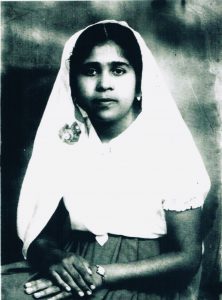
Zubaidah Khan
Young Zubaidah Khan was the founder of the British Guiana Muslim Women’s League (BMWL). She attended Carmel R. C High School in British Guiana and was a qualified teacher. This I believe was an offshoot from the Sadr’ Islamic Anjuman of Guyana. She, unfortunately, died on a visit to Banares, her father’s homeland in 1956. Zubaidah was a strong, brave and brilliant woman who passed too early to complete her mission. She was the daughter of Naseer Ahmad Khan who sold Islamic Literature at the Stabroek Market. Her mother was Sara Khan, and she was the sister of Shafeek Ahmad Khan; Rafeek Ahmad Khan; and Shabir Ahmad Khan.
Azeema Mazarally Rahaman, Counsellor
Breaking barriers, former Counsellor of Corriverton, Azeema Khatoon was from the Mazarally clan of Skeldon. She was married to Shehzade and Abdool Rahaman’s eldest son, In Rahaman. Azeema was a Counsellor of Corriverton in the 1960s. She was also very active in the family’s sawmill business. Azeema used her office to bring attention to the needs of the people of Corriverton and expanded ties with Nickerie.
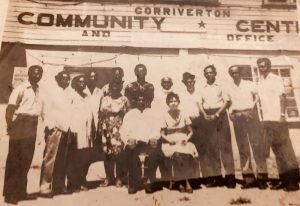
Azeema Rahaman is seated front row, right
Azeema Khatoon and her husband, Ein Rahaman later relocated to
Crabwood Creek, where they established their own sawmill. “Aunt Azeema was a very kind lady,” said her niece, Nilofar Singh (Rahaman).
“In a time when women were not encouraged to be more than mothers and wives, Azima broke ranks and showed what is possible. She is a hero,” said Ms Laila Mcdoom, another Guyanese woman who also broke many barriers to success.
The Sankar Women
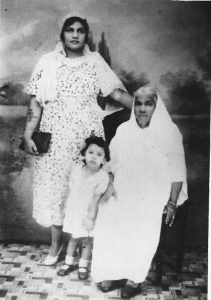
Mrs Lyla and Amna Sankar’s Grandmother, Sakinatul, seated, was born in Benares, India. Also, in the picture is one of her daughters, Aunt Zaibunissa Mcdoom (Twin). She lived on Brickdam Road, Georgetown.
Amna Sankar won her first case when she defended her uncle Shaheed Sankar after returning from the UK. She was Queen’s Counsel. Among the first group of females to attend Oxford University Law School. Amna was known as Aunt Goldie. She recently died in Switzerland. Like her sister Lyla, a businesswoman and Bishops educated, they were born in Suriname. Their mother Zohorah (Joree Mamee) Chan from Maichony, was a dominant figure who excelled in expanding the family businesses.
Aunt Lyla was born in 1930 and Amna who is older than her is a few years apart. These women come from a family of #78 Corentyne who moved to Suriname and Georgetown to seek business opportunities and to afford their children a good education.
Their parents were Amin Sankar and Zorohrah Chan. Their grandfather Sankar (Maula Baksh) was the son of Ramessar. Ramessar, a Brahmin Hindu converted to Islam and married Khadmi of number 78 Village. Sankar was married to Sakinatul, sister of Nur Khan, Qabil Khan, Zainab and Shehzade of # 78. Among the children of Sankar and Sakinatul were Isahaq, Ashim, Batulan, Nyjamunissa (Zaitoon), Yaseen, Amin, Shaheed, and Zaibunissa (Twin). Ahmed Aminool Sankar’s mother was Zabieda.
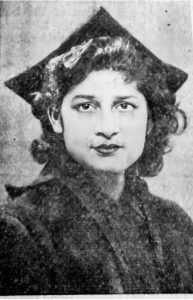
Mrs A. Sankar (Amna)
Three Sankar brothers had Amerindian, Chinese and Black mistresses. Amin Sankar and Zohorah of Main St. took it upon themselves to see that the children of these relationships were cared for. Sakinatul Khatoon cared for Ahmed’s mother after she fell ill of cancer. Joree and Lyla would help raise children of the less fortunate of the family.
Old Sankar started with a bus taking children to schools, dry goods traders, and cinemas like Radio City; then two of his sons Amin and Ahmad rose to new heights when they brought the first Mercedes and Volkswagen franchise to Guyana. They grew richer and bought Maida Estate, Corentyne, Hope, Park, and Waterloo Sugar Plantation, Suriname.
Lyla and Amna came from liberal Muslim families who were driven to assimilate, educate and obtain wealth. They had the full support of their parents. In fact, Aunt Lyla’s father provided her and Alston with an interest-free loan to start her own business. They were privileged yet hardworking and ambitious. Lyla ran a successful furniture business with her husband Alston Kissoon who died during an Air India plane crash over Switzerland. She would eventually marry his brother, Hemraj Kissoon. Many other Muslim women, and the majority to be correct, came from traditional families who sought to be self-employed. I think these two women eventually converted to Christian
Shalimar Ali-Hack, DDP of Guyana
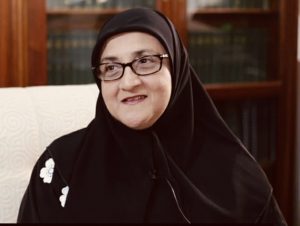
Shalimar Ali-Hack, DDP of Guyana
The first in many is the Director of Public Prosecutions [DPP] of Guyana, Ms Shalimar Ali-Hack. She is the daughter of Mohamed Ali and Lorine Ali Branco who grew up in Georgetown. She completed a degree in Sociology at the University of Guyana and then moved on to the Hugh Wooding Law School in Trinidad.
“Throughout the years she has been able to accomplish many firsts in the land of her birth including becoming the first Muslim lawyer to become Senior Counsel, the first Muslim woman to be allowed to practice in full Muslim traditional garb and the first Muslim woman to be appointed DPP.” (KN, August 18, 2019)
“I came back intending to serve for five years, but it has now been 29 years…I always say that everything always happens by the will of God and only He knows how long I will continue to serve,” she added. (KN).
Ms Ali-Hack is a practising Muslim who is associated with the Central Islamic Organisation of Guyana [CIOG]. She is committed to the advancement of women. “This has seen her travel the length and breadth of Guyana seeking to educate Muslim women and girls on their religious roles and on the laws of the land as well. She has also been doing this through the Gender and Equality Commission, on which she sits as a Commissioner.” (KN)
Ms Aleema Nasir
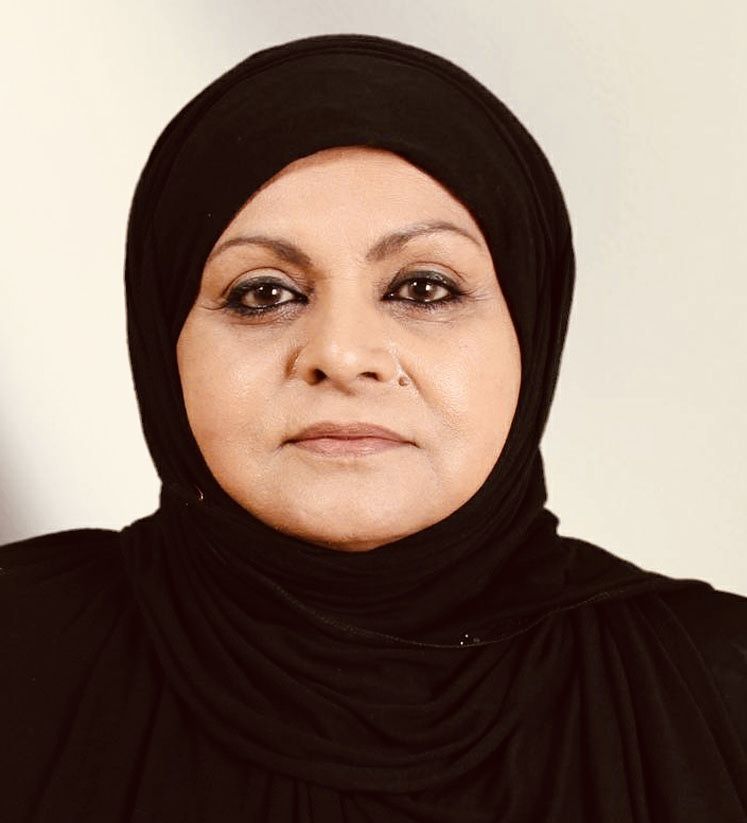
Ms Aleema Nasir
Ms Aleema Nasir was recognized for her work with women, children, the elderly and domestic abuse when she was awarded the Arrow of Achievement Medal in 2011. Aleema Nasir is the head of NACOSA, the women’s arm of the Central Islamic Organization of Guyana (CIOG). She is also the Chairman of the Human Rights Committee on Children.
Her father Mansoor Nasir, who hails from Vreed-en-Hoop was a well-respected solicitor, says B.S. Shadick. Her mother was Fazeela, a native of Trinidad. Aleema is also a mother of three who returned from abroad to dedicate her time, skills and talent to the less fortunate in our society. She also has four brothers, Maulana Siddique, Idris, Mobeen and Naeem who was the owner of Bakewell holdings.
In an interview with the media in 2018, she said, “My portfolio was women and children and we have been to all the areas on the coastland and that’s where my concern for children started because I saw some of the hardships they go through, the challenges they face and not have nowhere to turn to for help and that caused me to want to do something.”
“… That is only one example of elderly abuse and I have seen too much going on and that is why we try to do some programmes, especially for people who have given to the community… We bring them together and have a little get together for them and have a doctor and give them a little advice. This is done at CIOG,” She added (Oct. 14, 2018).
Bibi Shariman Neshaw Ali
Begum Bibi Shariman is the First Mother of Guyana, whose son is President Mohamed Irfaan Ali, and no mother couldn’t be more proud of this achievement. She is the wife of Janaab (Sir) Mohamed Osman Ali of Leonora. Bibi Shariman Begum hails from Leguan where she dedicated many years as a teacher from the age of 16. All in all, she has been a teacher for 39 years. She retired as a teacher and served as an education officer between 2011 to 2015. For eight years Bibi Shariman was also the director of a private school in Canada.
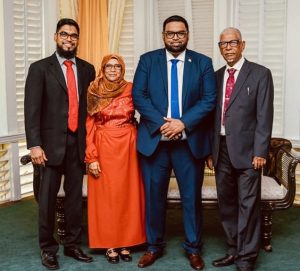
Begum Bibi Shariman, mother of President of Guyana Irfan Ali (standing right of her), another son Mohamed Aqtar Ali is standing to her left, her husband Mohamed Osman Ali is standing to right.
Besides the president of Guyana, she is the mother of another son, Mohamed Aqtar Ali. Bibi Shariman Begum has remained “down to earth,” and a proud mother of the president of Guyana.
Bibi Shariman is the daughter of Shira Dildar and Ayube. She was born in Leguan and became a teacher, first in Hogg Island, in the Essequibo River. That is where she met her husband, Janab Osman Ali who is from Leonora. Osman Ali is the son of Bibi Sakina Begum, a PPP activist.
Her mother, Shira was the daughter of Hameed Dildar who was the son of Ms Bibi Safora Shadick’s maternal grandmother’s second husband Dildar, whom she married after Syed Mohamood died.
“Dildar was a very good, hardworking husband and father. Another of his sons, Haniff, was the Imam of Maryville Masjid until his death,” says Ms Shadick.
“Irfaan spent all of his school holidays with Shira and Ayube in Leguan. He calls her Maa. She lives with a son in Canada.”
“Dildar is my grandfather, being my grandmother’s second husband. He brought up my mother and her sisters. Shariman’s maternal grandparents were Hameed Mamoo and Roni Mamee. Hameed was killed and left in canefields on the West Coast Demerara,” recalled Ms Shadick.
Shadick added, “Roni Mamee raised her children alone after his death. He used to drink quite a bit. All very poor people. Rice farmers.”
In discussing Leguan, Bibi Shariman Begum said, to the Guyana Chronicle in May 2012, “residents there lived like ‘one big happy family, and were not pretentious at all. “Growing up in Leguan taught me so many things,” she said. “The people there had an earthy thing about them. It was a joy growing up in Leguan. You didn’t grow up with feelings of racism, regardless of what your religion was, regardless of your political affiliation.”
“Growing up in Leguan shaped the person I am today because I feel that I am a very simple and unassuming person. I can relate to anyone, regardless of any barriers. That is what Leguan did for me,” she said to the Chronicle.
Begum Shariman Ali’s success as a teacher is rooted in her philosophy of believing in all her students, setting high standards and expectations, and building relationships with her students.
Stories of Leguan by Bibi Safora Shadick
The Khan’s of Danielston, Essequibo
Through the marriage of her grandfather’s sister, Munuwan to Abdool Rahman Khan of Maryville, Plantation, were some offsprings, Latifan Nissa, 1904, Ameena Eisha, Hamidan Khan and Majeed Khan. Latifan Nissa was married to Omar Khan of Danielson and had the following children: Hassan, Jahan, Jamaal, Ayube, Shabeer, Sulaiman, Sultan, Farouk and Mansoor. Ameena was married to Haniff Rayman and after his death to Abdool Safeek. Majeed Khan was married to Halima Ghangir (Jahangir) who perished during the 1934 Maryville massacre.
After her death, he was married to Mahanigar (Mehrnigar). Ms Shadick Gaphur is related to the Khan clan of Danielson. Abdul Gaphur was “of course at the funeral, in fact, he actually arranged the funerals. His sister was killed too. The mother of Azeez and Nazir.” One startling detail she shared about the case was that “The police were even investigating him for the murders,” said Bibi Shadick Gaphur.
The large plantation house where the Massacre of 1934 took place today is now under the occupation of Nazim Dildar (Biggs), who is the son of Hanif Dildar, and of course, Hanif was the brother of Ms Safora Shadick’s mother Miriam. Hence, Biggs is related to Bibi Shariman Ali.
I visited Maryville in 2021 and had the opportunity to visit the Plantation House which is smaller in size now. It was a pleasant visit, and homecoming for me since my ancestors, Jahangeer Bux Khan and his spouse, Mehruth Yearally arrived in Maryville in 1875. I visited the Qabarstan of the massacre victims which is next door to the house and Mr Gaphur is also buried there.
The Mahmad Family
Mahmad is Leo’s son. I believe they were from the Parika area. In Leguan they lived near my grandfather and the Maryville School which I attended. They are not, to my knowledge, related to the persons you have so far documented. Separate family altogether.
The Bagh Khan Family
Ms Shadick Gaphur is also related to the Haniff Bagh Khan family of Leguan. “Mrs. Bagh Khan was my grandmother Subrattan’s first cousin. They are a big family of twelve children, and were the proprietors of Success Estate,” she revealed.
